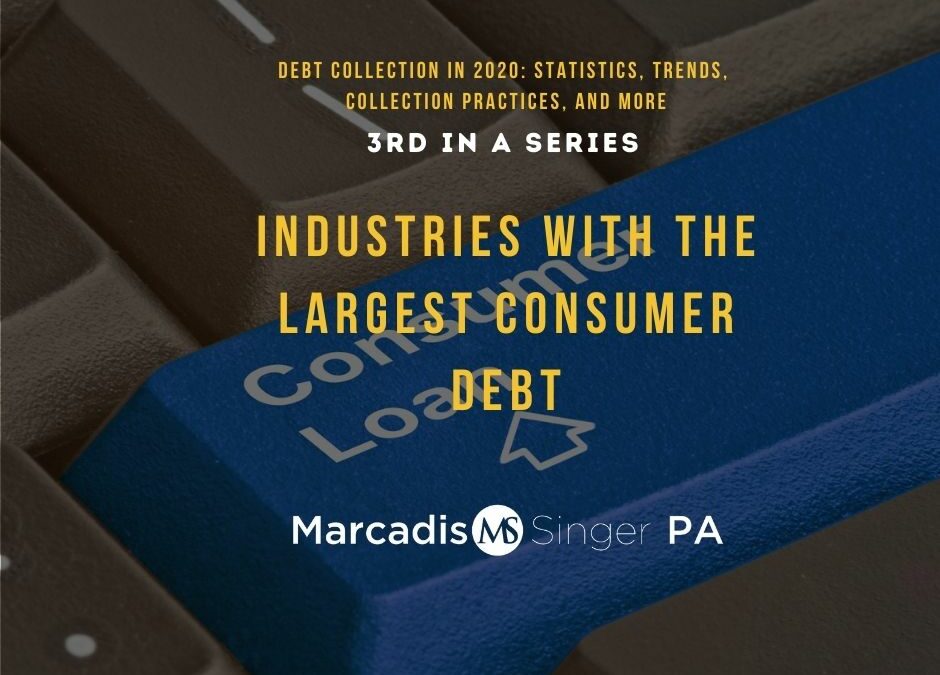Industries with the Largest Consumer Debt
- As previously stated, almost 30 million Americans have at least one debt in collections, and roughly one-fifth (19.5%) of credit reports contain one or more medical collections tradelines. Non-medical collections tradelines are found in about one-quarter of all tradelines (24.5%). But, in different businesses, how much money do consumers normally owe? The following are some alarming statistics about the occurrence of unpaid invoices and amounts owed:
- Credit Card Debt: The average American household owes around $15,000 on credit cards. 9 million credit cards were issued in April 2019, with a total credit limit of $34.6 billion. This is an increase of 8% year over year in originations.
- Student Loans: Today’s graduates in the United States have an average debt of $29,000 in student loans. Nearly half a million student loans were originated in April 2019, with a total new loan volume of $6.6 billion, a 2.8 percent drop year over year.Medical Bills: 41% of working-age Americans are paying off a medical debt or have medical bill problems, and 52% of debt collection actions in the United States include medical debts.
- Mortgages: In the United States, the average mortgage debt per household is around $150,000. 640,714 mortgages were originated in April 2019, totaling $179 billion in mortgage lending activity. This is a 6.5 percent increase in mortgage loan originations year over year.
- Vehicle Loans: In April 2019, 3 million auto loans were originated, totaling $52.8 billion in new loans, an increase of 3.6 percent year over year.
Unexpected changes in financial circumstances, such as the loss of a job, can leave families unable to pay their monthly expenses, causing them to default. If a consumer fails to pay on a defaulted account or loan within a reasonable amount of time, the account is frequently transferred to collections. When it comes to credit card debt, credit card firms generally have their own in-house collections departments, and collections activities begin as soon as a payment is missed.
Credit card debt isn’t the only type of debt that triggers collection efforts. Student loans are another typical defaulted loan, and it’s simple to see why, with today’s college grads graduating with an average of $29,900 in student loan debt.
- The Federal Reserve Board publishes data on consumer debt in the United States on a regular basis. The following are the major holders of outstanding consumer credit, according to the latest recent data (January 2020):
- Depository Institutions: $1,428.3 billion
- Finance Companies: $561.3 billion
- Credit Unions: $342.3 billion
- Federal Government: $949.7 billion
- Non-Profit and Educational Institutions: $44.9 billion
- Nonfinancial Business: $38.5 billion
- Pools of Securitized Assets: $46 billion
As of December 2019, revolving credit accounted for $1093.2 billion of total outstanding consumer credit, while non-revolving credit accounted for $3097.5 billion. According to data from the Federal Reserve Board, student loans accounted for $1,643.2 billion of total outstanding consumer credit in December 2019, while motor vehicle loans accounted for $1,196.1 billion.
Consumer debt data is also collected by the Federal Reserve Bank of New York.
The Federal Reserve Bank of New York’s Center for Microeconomic Data released a Household Debt and Credit Report for the fourth quarter of 2019, finding that household debt “increased by $193 billion, or 1.4 percent, to reach $14.15 trillion in the fourth quarter of 2019,” driven primarily by gains in mortgage, motor vehicle, and student loan debt.
Marcadis Singer, PA
5104 South Westshore Blvd.,
Tampa, Florida.
Phone: (813) 288-1881
